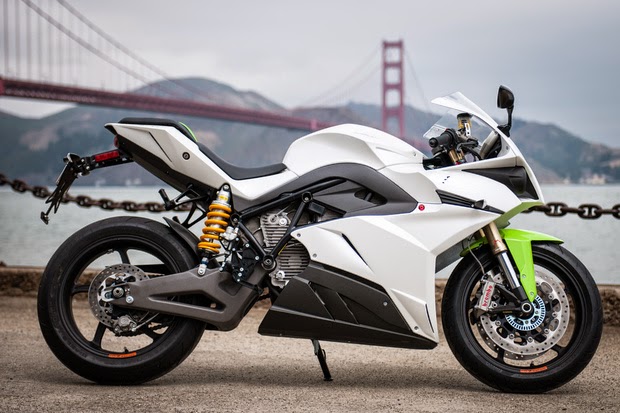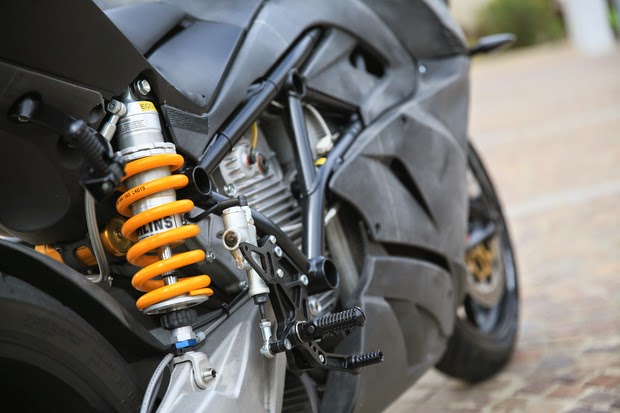 |
| Energica Ego in San Francisco |
CRP’s Energica Ego has been several years coming – in 2010, CRP came onto the TTXGP scene with the eCRP, a bike patterned after the Agni Motors entry in the 2009 TTXGP on the Isle of Man. This was the act of a motorcycle manufacturer getting their feet went in electric bikes, and with that first effort they won titles in the 2010-11 TTXGP and e-Power seasons. Fast forward to 2014, and the company has developed its own superbike, has begun a tour of North America showing off the Energica Ego. The Energica Ego is expected to go on sale in mid-2015 at a price beginning in the mid-$30k range. Today I was lucky enough to snag a test ride along with other journalists.
The first stop on the North America tour – Alice’s Restaurant, in the mountains just south of San Francisco – is a great choice There are plenty of twisty mountain roads, and Alice’s is a hangout for serious motorcyclers. Additionally, there are several electric vehicle entrepreneurs living close to Alice’s. For example, when I arrived this morning they were having a meeting with Martin Eberhard, the other co-founder of Tesla Motors besides Elon Musk.
The Energica Ego
The Energica Ego doesn’t share anything with the eCRP from several years ago. Everything you remember about those bikes, with which they had major wins in the 2010-11 TTXGP seasons, forget all that. This is a complete, ground up, custom motorcycle design, just as you’d expect from a company like CRP.
The CRP group is a family business based in Modena Italy, with decades of experience in technological achievements. They supply parts and technological expertise in Formula 1 and NASCAR racing, and to NASA for spacecraft.
The components and overall design of the Energica Ego is a clear simple statement: This is a proper superbike, that happens to be electric. And that’s not just my opinion – while hanging out with the bikes, several motorcycle riders came by and said the same thing. They dotted all the i’s and crossed all the t’s.
Those components? Try, Marchesini Forged Aluminum wheels front and back, Pirelli Diablo Rossoi tires front and back, Brembo disc brakes front and back, Marzocchi front suspension and Ohlins rear suspension. Oh, and there’s an ABS system from Bosch that CRP is working on validating.
The drive train is a 100 kilowatt permanent magnet AC (oil cooled) electric motor, mounted above the swing arm pivot point, driving the rear wheel through a single-gear transmission. This system produces 190 Nm of torque.
The 11.7 kilowatt-hour battery pack is rated for 1200 charge cycles. It has a 3 kilowatt on-board charger, and a level 2 charging port underneath the seat, for a 3+ hour recharge time. Additionally the charging port will support DC Fast Charging using the SAE Combined Charging System plug, giving a 30 minute recharge time (to 85%).
The bikes on display didn’t have the fast charging support, but it’s on the spec sheet, and the charging port has the appropriate cutouts. They were showing both the American style J1772 plug and the Mennekes Type 2 plugs on different bikes.
 |
Mennekes type 2 connector
This supports the J1772 charging protocol,
but through a different connector |
There are three (four, actually) competing DC Fast Charging standards: CHAdeMO, Combined Charging System, Tesla Supercharger, and the Chinese system. I’ve written this up in
a blog post on longtailpipe.com and
a page on greentransportation.info

. The CCS system chosen by CRP for the Energica is not (currently) deployed very widely, but it’s expected CCS-compatible fast charging stations will be more widespread as the other automakers (besides Nissan and Tesla) start ramping up electric car sales.
All this gives the Energica Ego an electronically limited top speed of 240 km/hr (150 miles/hr) and a riding range of about 100 kilometers at 100 kilometers/hr (60 miles @ 60 mph). Or, 50 kilometers at race speed (30 miles). The 0-60 miles/hr time is under 3 seconds. That’s enough range for club racing but not for regular racing.
The dashboard and rider controls are still under development. It currently supports four riding modes depending on your appetite for speed or economic energy use, and supports three regenerative braking modes. It has a cool computerized dashboard, and the plans discussed by the team are to make it even better and expand to multiple screens. There’s also a datalogging feature with which you can retrieve ride data over bluetooth, and the dashboard even includes a GPS receiver to tag that data with location markers. They wouldn’t commit to a navigation system on the dashboard.
The Energica Ego includes an ingenious reverse mode letting you back out of tight spots. This mode is initiated through manipulating the brake and start button, rather than by just twisting the throttle backwards like on the Vectrix. Speed is tightly regulated while in reverse mode, of course.
The Energica Ego 45
CRP is slated to launch two bikes in 2015. The Energica Ego, and the Ego 45. The latter is a limited production edition (45 bikes total) of the Energica Ego.
The EGO 45 line will be individually numbered, and feature some parts manufactured using CRP’s 3D Printing technology, as well as Zircotec ceramic and metallic coatings.
Enough about that, how does it ride?
The first thing you have to know is it’s a heavy bike – about 258 kilograms or about 530 lbs. Get used to it. That weight is in line with other electric superbikes, and is simply a fact of current technology.
Second – it rides like a dream.
The seating & riding position are like other race bikes. You’re on tippytoes when stopped, and while riding it’s probably best to rest on the “tank”.
You turn the bike on with a key near the dashboard. It’s not ready to ride until flipping what we’d normally refer to as the engine kill switch, and then by holding the right break and pressing what we’d normally call the start button. In other words, the controls are familiar and repurposed to controlling the electric drive train.
Once it’s ready to go you twist the throttle, and it goes as smooth as can be. Getting up to highway speed is effortless and quick. With no transmission there’s none of that dance between the clutch lever and the gear selector. That’s the convenience of the electric drive train, because you have fewer details to worry about.
Handling is excellent, and one almost doesn’t need the brakes. The regenerative braking handled the necessary slow-down-for-the-curve in most curves, with only a few requiring the manual brakes. Of course coming to a complete stop requires using the regular brakes.
Brakes are the familiar lever on the right handlebar, and a pedal for the right foot. There is no clutch or transmission, so the left hand and left foot have no controls to operate.
Unfortunately, I didn’t get to take a complete ride and I’m too embarrassed to say why. Let’s just leave it at that, okay? If I had made the full ride, I believe I would have had more glowing things to say about the Energica Ego, its that good.
About David Herron
David Herron is a writer and software engineer living in Silicon Valley. He primarily writes about electric vehicles, clean energy systems, climate change, peak oil and related issues. When not writing he indulges in software projects and is sometimes employed as a software engineer. David has written for sites like PlugInCars and TorqueNews, and worked for companies like Sun Microsystems and Yahoo.- The USA should delete Musk from power, Instead of deleting whole agencies as he demands - February 14, 2025
- Elon Musk, fiduciary duties, his six companies PLUS his political activities - February 10, 2025
- Is there enough Grid Capacity for Hydrogen Fuel Cell or Battery Electric cars? - April 23, 2023
- Is Tesla finagling to grab federal NEVI dollars for Supercharger network? - November 15, 2022
- Tesla announces the North American Charging Standard charging connector - November 11, 2022
- Lightning Motorcycles adopts Silicon battery, 5 minute charge time gives 135 miles range - November 9, 2022
- Tesla Autopilot under US Dept of Transportation scrutiny - June 13, 2022
- Spectacular CNG bus fire misrepresented as EV bus fire - April 21, 2022
- Moldova, Ukraine, Georgia, Russia, and the European Energy Crisis - December 21, 2021
- Li-Bridge leading the USA across lithium battery chasm - October 29, 2021
About David Herron
David Herron is a writer and software engineer living in Silicon Valley. He primarily writes about electric vehicles, clean energy systems, climate change, peak oil and related issues. When not writing he indulges in software projects and is sometimes employed as a software engineer. David has written for sites like PlugInCars and TorqueNews, and worked for companies like Sun Microsystems and Yahoo.















